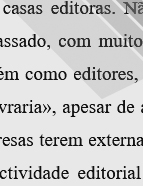

................................
The University of Coimbra's publishing activity dates back to the mid-16th century when there was already a printer and printing equipment at the university's service. But the University Press was only created in 1772, after the Pombal reform, with new and better equipment. At the time, it essentially published the works of professors, which led to a fall in business among the city's printers. But this activity slowed down in the first half of the 19th century - as a result of political instability and teaching methods that were not conducive to stimulating book consumption - and some degree of disinvestment may be noted: there was a decrease in the number of works published and income came mainly from other typographic work, such as the composition of administrative books. From the 1860s onwards, a reversal of the cycle is observed, with greater investment and more publishing. In turn, this new cycle came to a close at the end of the century as a result of the economic problems that had assailed the country, disagreements between the publisher's management and competition from other publishers in the city (particularly França Amado). But the institution recovered during the Republic. However, the publishing activity of the University Press, which despite the various cycles was never interrupted, came to an abrupt end in 1934, when it was abolished by the Estado Novo, at the time of its direction under the historian Joaquim de Carvalho, a professor at the University of Coimbra, who had adopted a very diversified publishing policy. The need to prevent an institution with significant book production from escaping the regime's control, the atmosphere of political tension and even the desire to benefit the private industry were possibly among the reasons behind its extinction. The university did not contest the decision and the books went on to be published with the reference "by order of the University" until the publishing house was relaunched. (F. T. Fonseca et al., Imprensa…[Press], 2001.)
Its catalogue was intrinsically linked to university life. Thus, there was an abundance of compendiums, publications on law and philosophy and legislation collections. But there were also works of a literary and religious nature; or related to the internal life of the university, such as regulations. It also published history books, mainly by historians linked to the university - but not only - and manuals to support classes.
